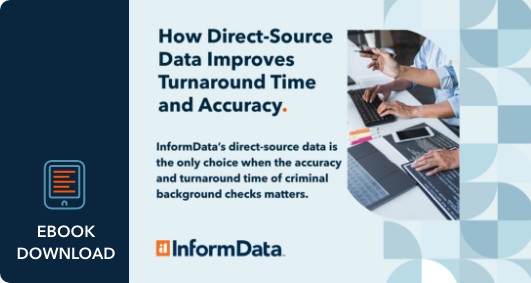Over the past 18 months, the employment landscape has undergone a radical transformation that continues even today. Companies are hiring at historic rates as unprecedented numbers of workers leave their jobs and start new ones, try out new, gig-based employment models, or re-enter the workplace to compensate for inflation. Rising costs for nearly everything contribute to the instability.
For CRAs and background screening companies, the current employment landscape represents both an opportunity and a challenge. The opportunity lies in the sheer amount of background screening work available. As a CRA, this is a chance for you to grow your business, deepen your client relationships, gain new clients, and profit.
But the challenge comes in fulfilling the deluge of orders with the speed, accuracy, and customization levels your end-users expect. Just doing more, the same way you’ve been doing things, doesn’t look like a winning strategy.
Now is not the time to get mired in backlogs or make mistakes. Competition in the background screening arena is intense, and end-users have very little incentive to stick with a CRA that drops the ball or fails to make their lives easier.
Market analysis: Why the background screening business model must change
Is your background screening company dealing with an overwhelming surge of orders and end-users who are even less patient and more demanding than usual? It’s likely due to one or a combination of the following six market trends impacting your business:
1. Post-Pandemic hiring continues at a blistering pace
The U.S. job market cratered at the height of the COVID pandemic. But the post-pandemic recovery era has seen equally dramatic increases in hiring as employers strive to re-attain their pre-pandemic staffing levels.
Job openings hit a record high in March 2022 (at 11.5 million) and continued near that level through April (the last month for which data is available). Experts expect the tight labor market to persist despite rising inflation and concerns about recessionary pressures.
What your end-users need: With the pandemic in the rearview, consumers are spending money again. Many have a “war chest” saved from curtailed activity during the pandemic and they are eager to spend it now. Your end-users are looking to ramp up rapidly to meet the demand, and for that, they need to process background checks quickly, make hiring decisions, and fill seats. Turnaround time is their utmost priority.
2. ‘The Great Resignation’ turns to the ‘Great Regret’
Many of the workers who left their posts during the “Great Resignation” are having second thoughts.
One study found that 72% of workers who changed jobs as part of the Great Resignation found their new positions to be “very different” than they expected. Nearly half of those workers are trying to get their old jobs back. In addition, many who opted to retire early, are finding retirement isn’t what they expected, or that inflation has altered their budget calculations and are re-entering the workplace.
What your end-users need: Whether you call it the “Great Resignation” or the “Great Regret,” the outcome is the same: job churn. Your end-users are stuck in an increasingly frantic cycle of hiring and rehiring — which only increases the need for background screening done quickly and accurately.
3. Gig workers on multiple platforms
By the end of 2021, 16% of Americans had earned money through an online gig-work platform (including ride-hailing apps, shopping or delivery services, and apps for helping with chores and household tasks). About a third of those classified gig work as their “main job,” and nearly 60% said gig work was essential or important for paying for their basic needs.
Gig work is here to stay, and its popularity will undoubtedly grow over the coming months and years, with more and more workers participating on multiple platforms — TaskRabbit during the day, for example, and Uber on nights and weekends.
What your end-users need: Gig-economy companies rely on background screening to ensure their workers are trustworthy, safe, and law-abiding. Just a few criminal incidents can irreparably tarnish a gig-economy company’s reputation. Gig-economy staffing and human resource managers expect criminal background checks to be accurate, exhaustive, and fast.
4. Retirees re-entering the workforce
Millions of retirement-age workers left their jobs during the pandemic, many planning to make their exit permanent. However, over the past year, about 1.5 million of these workers have returned to the workforce, enticed by flexible working arrangements and unable to keep up with rising costs.
What your end-users need: Most employers would be happy to welcome an experienced “retiree” back to their team and would be eager to complete the background screening process as quickly as possible.
5. A new era of inflation
The annual inflation rate in the U.S. hit 8.6% in May, without accounting for increases in energy and food, the largest annual increase in more than 40 years. Consumers are feeling it at the gas pump, in the grocery store, and in the cost of housing. Inflation is hitting some businesses hard, too, with costs for many types of materials climbing to astronomical heights.
What your end-users need: With costs for everything else increasing, businesses are looking to contain costs and gain efficiencies wherever possible. Background checks are one area where companies may look for stable, predictable pricing.
6. An ever-changing legal landscape
“Regulatory litigation pressure has had a direct correlation with how CRAs run their background screening program and what the end-users are buying,” said Bryan Snow, Vice President for Strategic Business Development at InformData, during a recent webinar.
CRAs and end-users are held to incredibly strict standards when it comes to reporting, so going through multiple layers is no longer advisable. You need to be as close to the data source as possible so that nothing is lost in translation and custom reporting guidelines can be managed consistently.
What your end-users need: In today’s regulatory climate, the feeling is, “If you could have known, you should have known.” The background screening process is highly scrutinized. End-users are looking for thorough, transparent background screening processes that shield them from risk, along with customized reports that make actionable information readily accessible in the format they require.
How doing more of the same fails CRAs
Unfortunately, CRAs that rely on the prevailing data acquisition methods — such as managing a network of regional data vendors or employing teams of salaried researchers — can only adapt so quickly to the skyrocketing demand for accurate, customized background screening reports driven by the six labor market trends described above.
As we reported in a recent article, CRAs that rely entirely on a network of regional data vendors can suffer from a “middleman” problem. For example, in this model, conviction information is filtered up through a chain of subcontractors and distributors, giving CRAs little control over costs, quality, turnaround times, and customization.
In addition, these CRAs must dedicate time and resources to vendor management — time and resources that would be better spent on more productive, revenue-generating tasks, such as prospecting for new clients.
CRAs that choose to employ their own salaried background screening researchers cannot scale up quickly in response to demand surges. Plus, they face the same talent recruitment and retention challenges as businesses in nearly every field right now.
Gain a competitive edge today with Direct-Source Data®
Background screening companies and CRAs now have a modern option for acquiring criminal background screening data, designed for the current labor market: partnering with a nationwide Direct-Source Data provider.
A nationwide Direct-Source Data provider (such as InformData) can help your business compete and grow in today’s employment landscape by removing middlemen and putting you close to original conviction records without the hassle or overhead of managing your own salaried researchers.
Direct-Source Data partners eliminate the layers of middlemen that get between your company, your end-users, and the data, giving you the flexibility to provide the transparency, turnaround time and customization your end-users demand. The look and feel of reports is consistent from jurisdiction to jurisdiction. The Direct-Source Data model also enables flat-rate pricing, making it possible for you to offer your customers stable, predictable costs.
Most importantly for your end-users, when you work with a Direct-Source Data provider, your business can scale up quickly as the market demands. There’s no need to train new W-2 employees, search for new vendors, or wait your turn while your vendors serve other clients.
A direct-source provider like InformData has the nationwide reach, technology, and expert-built processes to help you stay out of the backlogs, ensuring the lightning-quick turnaround times that will propel your business and your end-users forward through today’s unpredictable economy.


